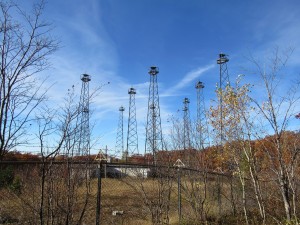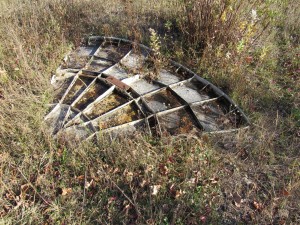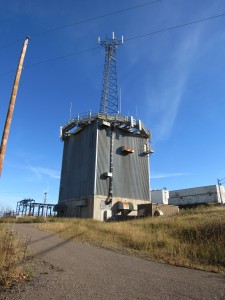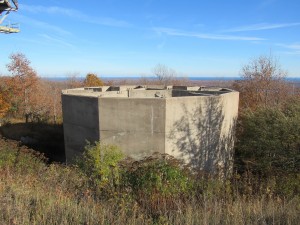The Air Force Station located in Michigan’s Keweenaw Peninsula, called Calumet Air Force Station (or CAFS for short) had an important mission; watch the northern skies for enemy attacks. Between its creation in 1950 until its eventual decommissioning on September 20th, 1988, the station was a significant part of both the area’s economy and community, as well as the nations defense. Beginning in the 1960s, the US Air Force implemented a new technologically advanced air surveillance system, the Semi Automatic Ground Environment (SAGE), which consisted of several semi-automatic outpost stations that sent aerial intelligence to central command centers. The C.A.F.S. became an integral part of this system as a long range radar station.
The 665th Aircraft and Control Squadron was assigned to the C.A.F.S. and construction began in 1950 in a remote area of the Keweenaw Peninsula just northwest of Gratiot Lake. Construction was expedited and the squadron was stationed on there on November 27th, 1950.”One hundred twenty Air Force personnel were on hand, 108 enlisted, (and) 12 officers.” (Scanlan, 2006) The initial radar equipment included a height finder tower, which would determine the altitude of oncoming aircraft and missiles by means of a large moving radar detector, as well as a long range radar dome.
Cold (War) Hard Truth
The decade leading up to the creation of the Semi Automatic Ground Environment (SAGE) is often thought of in terms of poodle skirts and cars that look more like boats than highway vehicles, however, the often forgone (and critical in shaping the world for the next 50 years) reality of the 1950s is one anchored in fear. Both the American people and the American government were terrified of the Soviet Union and the communism that it represented, and this impacted the times far more than any fashion statement could. One particular incident that sums up the hysteria of the 1950s was the accusation from the American Legion of Illinois that the Girl Scouts of America was instilling un-American values in its scouts. The political cartoon below is a response to this situation. Looking closely one can see that one of the officers in the scene is holding a ‘How to detect subversion and witchcraft’ manual, which makes light of the situation at hand. Another notable detail is that the men in the scene are all overweight, a common way to portray bumbling politicians in political cartoons.
Another example of the physiological threat of communism is evident in Joe McCarthy’s “Enemies from Within” Speech. In his speech, McCarthy states that “in my hand (I have) 57 cases of individuals who would appear to be either card carrying members or certainly loyal to the Communist Party, but who nevertheless are still helping to shape our foreign policy” (McCarthy, 1950) This ‘knowledge’ that the US had been infiltrated by communism which was now public certainly helped to fuel the Red Scare. The threat to the US was not only a physiological one, but it was also a very physical threat. Following the end of WWII, the Soviets and USA entered a ‘cold war,’ which led to of the stockpiling of large amounts of nuclear warheads. This, paired with the development of intercontinental ballistic missiles posed a huge threat to the US and its safety. It was now possible for the soviets to detonate a nuclear warhead on American soil with the push of a button, and with little risk. The creation of the SAGE program in the early 1960s was a response to both the national hysteria created during the ‘Red Scare’ and the necessity for faster defense against bomber jets and ballistic missiles, which had been a source of national concern.
C.A.F.S. Gets Promoted

Beginning in the 1960s, the base received a major upgrade in both responsibility and technology. The nation had made the transition from independent, heavily manned radar stations to the technologically advanced SAGE stations. These types of stations reduced the need for numerous radar operators because most of the monitoring was automated. They also decreased detection and response times to enemy invaders because the intelligence was sent directly through the SAGE network at the speed of light. This transition, however, did not completely satisfy the safety needs of the country as outlined in the annual report of the secretary of defense in 1964. “The vulnerability of the Semi-Automatic Ground Environment (SAGE) system to a missile strike presents a key problem in this area. (in order to) provide a more viable warning and control system, widely dispersed, semiautomatic Back-Up Interceptor Control (BUIC) stations, protected against radioactive fallout, (were) being constructed” One such facility chosen to be upgraded was the Calumet Air Force Station, which immediately began to receive the latest in high-tech computer technology. In the event that the main direction center in Marquette was destroyed, the newly upgraded BUIC station in the Keweenaw would continue to interpret readings from other radar stations in the sector. This change of assignment increased the need for manpower, and in 1966 there were 224 military personnel and around 200 dependents stationed in the remote base.
This small town not only had upgrades to its military technology but it also required more housing, food stores, and amenities. A large commissary was added where “Airmen could purchase a much wider range of food and merchandise at federally subsidized prices” (Scanlan, 2006) This is not to say that the base was lacking of amenities prior to the switch, in fact in 1959 the base had a dentist who would “Set up dental quarters for a two month period.” He was even “Equipped with an X-Ray Unit” (The Daily Mining Gazette, 1959), which gives an idea about how developed of a community the C.A.F.S. really was. The picture below, which was taken in the fall of 2015, shows the large amount of dormitories and living quarters that were provided to the people stationed there. Although each building on the premises is in disrepair today, it is still easy to see what they were used for. One building in particular, which was most likely the church still has pews and an organ (albeit destroyed), as well as a large crucifix above the door. Some of the buildings had large open rooms that seemed like central community centers where the squadron and their families could socialize. This photo does capture the scale of the operation form the perspective of what life would be like for individuals and families living on base.
A Tour of the Facilities
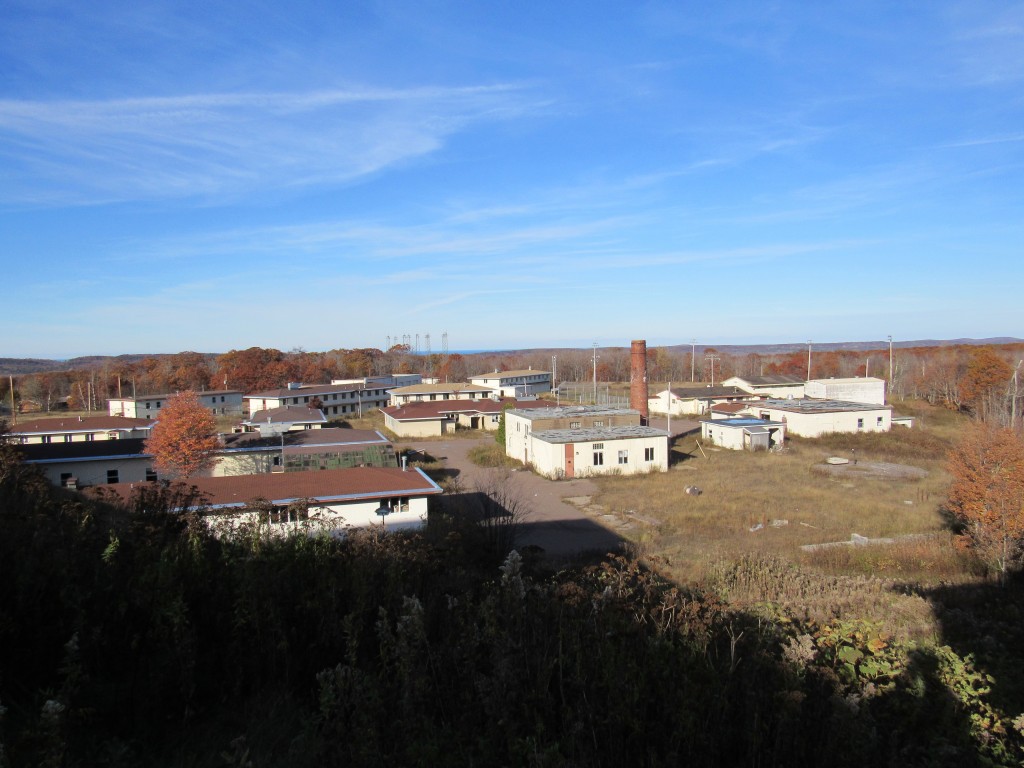
These photos, that show some of the radar equipment and the ‘business’ end of the base can shed some light on the types of radar used. Firstly, the reason that this site was chosen for a nationwide radar station is evident in the picture overlooking lake superior. Its placement on mt. Horace gives a panoramic view of lake superior, which would have been very advantageous in the collection of radar data. The photo on the top left of the gallery shows an array of radar towers that were separated from the main complex. On top of each of the towers was what appeared to be a mounting bracket and a platform for standing. On the ground next to one of the towers was part of what could have been a receiver dish. In the center of the array of towers was a building containing an entire wall of controls, electrical panels and connections. It is probable that these towers worked together to obtain an image of what was going on in the sky, which was sent via direct line to Marquette, MI where the largest computer in the world (SAGE) presided. The main building on the site, shown in the bottom left corner was massive in size. Unlike the other buildings at the C.A.F.S., this structure was far more industrial. The inside of the building has multiple structural beams stretching from floor to ceiling, and the walls are thick concrete making the entire structure look and feel like a shelter. Atop of this massive building is a large tower, most likely used for long range radar. During the years that C.A.F.S. was in use this tower would have been enveloped in a large dome giving it an even more space-age look. The shear size of all of these installations gives scale to the SAGE operation throughout the United States, and displays the importance of stations like Calumet Air Force Station in the nation’s security.
SAGE Promotional and Advertising Videos
“In Your Defense”, a promotional movie commissioned by the US Air Force explains the structure of the nationwide SAGE system. The idea behind SAGE was to connect all means of threat detection and quicken the response to these threats by allowing a computer to calculate positions of all objects in the sky. In order to effectively implement this system, the country was divided into several ‘sectors’ that did not necessarily follow state lines. (One including the Keweenaw) Each sector (all of which are shown below) was assigned a direction center, to which all of the sector’s radar data was forwarded to. Multiple adjacent sectors form a NORAD sector, in which there is a key point called a combat center.
There were several methods for a sector to obtain radar data, including long range radar, airborne early warning systems, Naval radar ships, gap filler radars, Texas towers (similar oil rigs), and commercial air movement info services. The combination of all of these radar systems gave a complete picture of what was going on in the sky. Each source of information constantly sends its results through a direct line connection to the sector’s direction center, which houses the IBM SAGE computer. The direction center determines if there are any hostile threats to the US, which it sends to the NORAD combat center. At the combat center the Air Force officers decide how to react to the threat, and have three choices for threat elimination; ground to air missiles, Nike Batteries, and fighter jet squadrons. With a push of a button a missile can be sent to intercept the threat. The Calumet Air Force Base in Michigan’s Keweenaw Peninsula was built to serve the purpose of a long range radar site, which would feed information back to the direction center located in Marquette, MI, K.I. Sawyer. C.A.F.S. therefore had an integral part to play in the SAGE program, effectively operating as the first line of defense against a northern attack.
The IBM SAGE computer was the most advanced computer of its day. It “used 3MW of power, and had approximately 60,000 vacuum tubes” and “weighed 250 tons” (History of Computing, 2001) and users interacted with the computer via a light-gun which would mark an object for tracking. Although the computer is better known as the IBM SAGE computer, its technical name is AN/FSQ-7.The AN/FSQ-7 was the backbone of the SAGE operation, and was shown to perform exceptionally well in the multiple tests conducted with false threats. The IBM SAGE Computer Advertisement shows a test of the system, which seems to nearly run itself from the point of data retrieval to sending a NIKE missile to intercept the target. This level of sophistication in the defense of the country helped to ease tensions and made America a much safer place.
Calumet Air Force Station’s participation in the SAGE program was vital to the security of the United States. In a time when tensions were high and civilians were worried about having a nuclear warhead dropped on their house, this system brought peace of mind. The advertisement for SAGE and the IBM computer displayed a level of patriotism while also letting the public know that the United States was strong enough to deter any threat. Not only was C.A.F.S. an asset to the nation as a whole but it was also an asset to its community, bringing people, money and attention to the remote area of Michigan’s Keweenaw peninsula. Visiting the site today gives an idea of the scale of the project, and sheds light onto what it might have been like to be stationed there, in the middle of ‘nowhere.’ Above all, this installment represents an era of technological advancement in the world which led to the creation of all modern computing devices. For these reasons, both the work that was done at Calumet Air Force Station and the station itself should never be forgotten.
Primary Sources
- The Daily Mining Gazette (November 23, 1959) Calumet Air Force Station Sizes Up to be Important Copper Country Economic Asset. Michigan Technological University Vertical Files
- Colonel Morton, John (narrator.)(nd.) In Your Defense.(Digitized Movie) Western Electric Company for The United States Air Force. Retrieved 11/10/2015.
- IBM (1960). IBM SAGE Computer Advertisement.(Digitized Movie). IBM. Retrieved 11/10/2015.
- IBM (1958). The SAGE/BOMARC Air Defense Weapons System. An illustrated explanation of what it is and how it works. IBM.
- Tetzloff, Thomas (2015). Living Quarters at Calumet Air Force Base. (Photo). Multiple Radar Towers. (Photo). Ruins of Receiver Dish. (Photo). Main Radar Building. (Photo). Radar Dome Base Overlooking Lake Superior. (Photo)
Secondary Sources
- Scanlan, Tom (2006) Calumet Air Force Station: A Brief History. Michigan Technological University Archives
- Craven, Carl (1988) The Calumet Air Force Station. Student Report. Michigan Technological University. SS315 History of the Upper Peninsula.
- Annual Report of the Secretary of Defense (1964) Continental Defense. pp. 11-15.
- Sage Computer System (2001) Lexikon Services. History of Computing
- McCarthy, Joe (1950) Speech at Wheeling, West Virginia. Congressional Record, 81st Congress, 2nd Session.
Further Reading:
- Wikipedia. Semi Automatic Ground Environment
- Wikipedia. Calumet Air Force Station.

